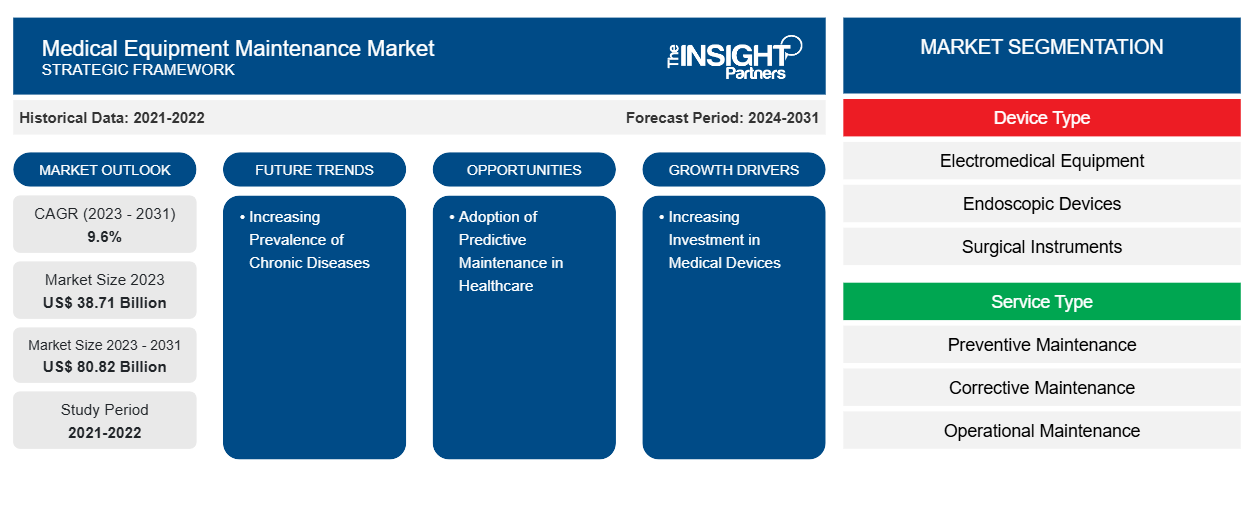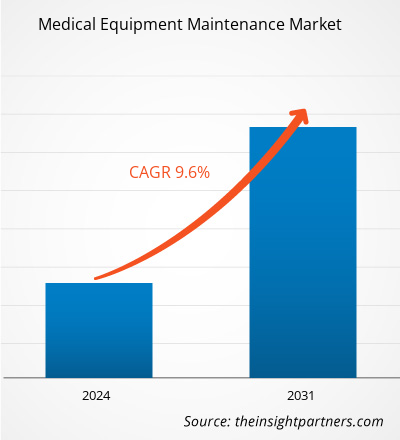The medical equipment maintenance market size in 2023 stood at US$ 38.71 billion and is projected to reach US$ 80.82 billion by 2031. The market is expected to register a CAGR of 9.6% during 2023–2031. Technological advancement in medical and diagnostics equipment is likely to remain key trends in the market.
Medical Equipment Maintenance Market Analysis
The rapidly growing medical equipment market globally and the increasing use of corrective maintenance are driving up demand for medical equipment maintenance. The increased prevalence of chronic diseases in the population contributes significantly to the demand for medical equipment maintenance. Innovation in service offerings and the use of IoT are creating opportunities for the medical equipment maintenance market.
Medical Equipment Maintenance Market Overview
In the medical equipment maintenance market, service providers address a wide range of needs, including corrective repair of durable medical equipment and specialized services for dialysis centers. With an emphasis on regulatory compliance, including cancer and lifestyle disorders, companies provide solutions for both multi-vendor and single-vendor OEMs.
Customize This Report To Suit Your Requirement
You will get customization on any report - free of charge - including parts of this report, or country-level analysis, Excel Data pack, as well as avail great offers and discounts for start-ups & universities
Medical Equipment Maintenance Market: Strategic Insights

-
Get Top Key Market Trends of this report.This FREE sample will include data analysis, ranging from market trends to estimates and forecasts.
Medical Equipment Maintenance Market Drivers and Opportunities
Increasing Investment in Medical Devices to Favor Market Growth
The healthcare industry is witnessing increased investment in medical devices such as X-ray machines, centrifuges, ventilator units, ultrasound, syringe pumps, electrocardiographs, and autoclaves is primarily increasing need for medical equipment maintenance services. Maintenance of medical equipment is essential to ensure that it functions correctly and is safe for patient use. Healthcare facilities increasingly rely on maintenance service providers to keep their equipment in good working order and reduce downtime. Modern medical equipment must be serviced on a regular basis to ensure that it functions properly. The complexity of new medical equipment is driving up the demand for specialised maintenance knowledge.
Adoption of Predictive Maintenance in Healthcare
Predictive maintenance in healthcare is the proactive monitoring and management of medical equipment to avoid unplanned downtime and assure optimal performance. Unlike traditional maintenance methods, which rely on fixed timetables or reactive responses to equipment failures, predictive maintenance employs real-time data and predictive analytics to foresee prospective difficulties and prioritize maintenance tasks according to risk and criticality. Healthcare organizations can shift from reactive to proactive maintenance methods by employing modern technologies such as sensors, data analytics, and machine learning. This will reduce costs, improve efficiency, and improve patient care.
Medical Equipment Maintenance Market Report Segmentation Analysis
Key segments that contributed to the derivation of the medical equipment maintenance market analysis are device type, service type, and service provider.
- Based on device type, the medical equipment maintenance market is divided into electromedical equipment, endoscopic devices, surgical instruments, and other medical equipment. The electromedical equipment segment held the largest market share in 2023.
- By service type, the market is segmented into preventive maintenance, corrective maintenance, and operational maintenance. The preventive maintenance segment held the largest share of the market in 2023.
- In terms of service provider, the market is segmented into a original equipment manufacturers, independent service organizations, and in-house maintenance. The original equipment manufacturers segment held the largest share of the market in 2023.
Medical Equipment Maintenance Market Share Analysis by Geography
The geographic scope of the medical equipment maintenance market report is mainly divided into five regions: North America, Asia Pacific, Europe, Middle East & Africa, and South & Central America.
North America has dominated the market. The region's ageing population, along with rising healthcare costs, has kept the need for medical equipment maintenance and after-sales assistance high over the years. Furthermore, stringent laws on quality standards and safety procedures have ensured that equipment maintenance remains a focus for both commercial and public healthcare facilities.
Medical Equipment Maintenance Market Regional Insights
The regional trends and factors influencing the Medical Equipment Maintenance Market throughout the forecast period have been thoroughly explained by the analysts at The Insight Partners. This section also discusses Medical Equipment Maintenance Market segments and geography across North America, Europe, Asia Pacific, Middle East and Africa, and South and Central America.
Medical Equipment Maintenance Market Report Scope
| Report Attribute | Details |
|---|---|
| Market size in 2023 | US$ 38.71 Billion |
| Market Size by 2031 | US$ 80.82 Billion |
| Global CAGR (2023 - 2031) | 9.6% |
| Historical Data | 2021-2022 |
| Forecast period | 2024-2031 |
| Segments Covered |
By Device Type
|
| Regions and Countries Covered |
North America
|
| Market leaders and key company profiles |
|
Medical Equipment Maintenance Market Players Density: Understanding Its Impact on Business Dynamics
The Medical Equipment Maintenance Market is growing rapidly, driven by increasing end-user demand due to factors such as evolving consumer preferences, technological advancements, and greater awareness of the product's benefits. As demand rises, businesses are expanding their offerings, innovating to meet consumer needs, and capitalizing on emerging trends, which further fuels market growth.

- Get the Medical Equipment Maintenance Market top key players overview
Medical Equipment Maintenance Market News and Recent Developments
The medical equipment maintenance market is evaluated by gathering qualitative and quantitative data post primary and secondary research, which includes important corporate publications, association data, and databases. A few of the developments in the medical equipment maintenance market are listed below:
- B. Braun Thailand, inaugurated the "B. Braun Technical Service Center", which will provide high-quality medical equipment repair and maintenance services. The newly launched center aims to support the public health system of Thailand in ensuring that it will be able to provide seamless healthcare support to its citizens. (Source: B. Braun SE, Press Release, July 2022)
Medical Equipment Maintenance Market Report Coverage and Deliverables
The “Medical Equipment Maintenance Market Size and Forecast (2021–2031)” report provides a detailed analysis of the market covering below areas:
- Medical equipment maintenance market size and forecast at global, regional, and country levels for all the key market segments covered under the scope
- Medical equipment maintenance market trends as well as market dynamics such as drivers, restraints, and key opportunities
- Detailed PEST/Porter’s Five Forces and SWOT analysis
- medical equipment maintenance market analysis covering key market trends, global and regional framework, major players, regulations, and recent market developments
- Industry landscape and competition analysis covering market concentration, heat map analysis, prominent players, and recent developments for the medical equipment maintenance market
- Detailed company profiles
Frequently Asked Questions
Which region dominated the medical equipment maintenance market in 2023?
What are the driving factors impacting the medical equipment maintenance market?
What are the future trends of the medical equipment maintenance market?
Which are the leading players operating in the medical equipment maintenance market?
What would be the estimated value of the medical equipment maintenance market by 2031?
What is the expected CAGR of the medical equipment maintenance market?
- Historical Analysis (2 Years), Base Year, Forecast (7 Years) with CAGR
- PEST and SWOT Analysis
- Market Size Value / Volume - Global, Regional, Country
- Industry and Competitive Landscape
- Excel Dataset
Recent Reports
Related Reports
Testimonials
Reason to Buy
- Informed Decision-Making
- Understanding Market Dynamics
- Competitive Analysis
- Identifying Emerging Markets
- Customer Insights
- Market Forecasts
- Risk Mitigation
- Boosting Operational Efficiency
- Strategic Planning
- Investment Justification
- Tracking Industry Innovations
- Aligning with Regulatory Trends





















 Get Free Sample For
Get Free Sample For